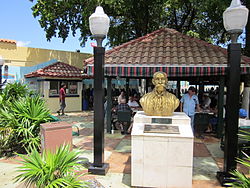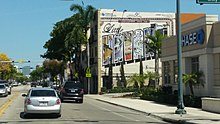
Back La petita Havana (Little Havana) Catalan Little Havana German Pequeña Habana Spanish هاوانای کوچک Persian Little Havana Finnish Little Havana French Little Havana Italian Little Havana Polish Little Havana Portuguese Маленькая Гавана Russian
Little Havana
Pequeña Habana | |
|---|---|
 Little Havana's Domino Park on Calle Ocho | |
 Little Havana neighborhood within the city of Miami | |
| Coordinates: 25°46′21.28″N 80°12′52.52″W / 25.7725778°N 80.2145889°W | |
| Country | United States |
| State | Florida |
| County | Miami-Dade |
| City | Miami |
| Government | |
| • City of Miami Commissioner | Joe Carollo (R) |
| • Miami-Dade Commissioners | Eileen Higgins (D) |
| • State House | Vicki Lopez (R) |
| • State Senate | Ileana Garcia (R) |
| • U.S. House | Maria Elvira Salazar (R) |
| Population (2010) | |
• Total | 76,163 |
| • Density | 21,815/sq mi (8,423/km2) |
| Time zone | UTC-05 (EST) |
| ZIP Code | 33125, 33126, 33128, 33130, 33135 |
| Area code(s) | 305, 786 |



Little Havana (Spanish: Pequeña Habana) is a neighborhood of Miami, Florida, United States. Home to many Cuban exiles, as well as many immigrants from Central and South America, Little Havana is named after Havana, the capital and largest city in Cuba.
Little Havana is noted as a center of social, cultural, and political activity in Miami. Its festivals, including the Calle Ocho Festival, Viernes Culturales/Cultural Fridays, the Three Kings Parade and others, have been televised to millions of people every year on different continents. It is also known for its landmarks, including Calle Ocho (SW 8th Street/Tamiami Trail), and its Walk of Fame (for famous artists and Latin personalities, including Celia Cruz, Willy Chirino, Gloria Estefan, Thalía, Julio Iglesias, and Desi Arnaz), the Cuban Memorial Boulevard, Plaza de la Cubanidad, Domino Park, the Tower Theater, José Martí Park, the Firestone/Walgreens Building, St. John Bosco Catholic Church, Municipio de Santiago de Cuba and others.
Máximo Gómez Park, also known as Domino Park is an integral part of Little Havana. Located on the historic Calle Ocho (8th Street) it is a place for Cuban immigrants to gather, drink coffee, smoke cigars, and play dominos. The park has also become a tourist destination, where non-Cubans can engage with immigrants.[1]
Little Havana is the best known Cuban exile neighborhood in the world. It is characterized by its street life, restaurants, music and other cultural activities, small business enterprises, political passion, and great warmth among its residents.[2]
In 2015, Little Havana was included in the National Trust for Historic Preservation's annual list of 11 Most Endangered Places.[3][4][5] In 2017, the Trust declared it a national treasure.
- ^ Whaley, Mirtha; Paul-Ward, Amy (2011). "Keeping Close to Home: The Ritual of Domino Playing Among Older Cuban Immigrants in Miami's "Little Havana"". Generations: Journal of the American Society on Aging. 35 (3): 22–27. ISSN 0738-7806. JSTOR 26555790.
- ^ "Archived copy". Archived from the original on July 4, 2018. Retrieved October 27, 2012.
{{cite web}}: CS1 maint: archived copy as title (link) - ^ "America's Most Endangered Historic Places - National Trust for Historic Preservation". August 28, 2024.
- ^ "Miami's Little Havana Endangered: Preservation Group". July 2015.
- ^ "Preservation group says Little Havana endangered: Travel Weekly". www.travelweekly.com.
